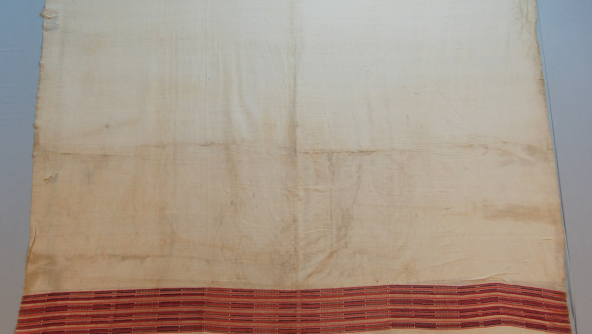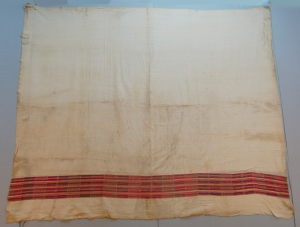In the second half of the nineteenth century, the inhabitants of Eastern Africa clothed themselves with textiles that came from many different places. There was, as in all pre-industrial societies, a lot of self-production, as households spun and weaved the cloth that they used themselves, and many exchanges took place only on the local level. There were a few African manufacturers with an old and prestigious tradition, who sent their goods beyond their regional borders: the cloth of the Somali towns of the Banaadir coast, for example, was renowned. And finally, there were foreign textile industries, which competed with each other to sell their goods further and further across the continent. African consumers used all these different options, and quite often combined them in creative ways, in order to dress themselves.
Handloom production of Banaadir cotton cloth (futa Banaadir), image from the Somali news channel Bilan Media, 2023 (https://x.com/MediaBilan/status/1717883240990519439). Even though the weaver himself is wearing a foreign T-Shirt, still today there is some market for local cloth.
Traditionally, long-distance trade had been dominated by cotton Indian exports. India was the first place where the plant of cotton had been domesticated[1], and as it was one of the richest and most advanced regions in the world, it produced many different kinds of textiles, for all purposes and all kinds of customers. Gujarat, Bengal, and Coromandel were the most important manufacturing areas, and the Eastern coast of Africa one of their many markets. Other textiles were comparatively less important, even though woollen cloth was appreciated in the cool Ethiopian highlands.
Things changed with the Industrial Revolution: industrial cloth was not just drastically cheaper than the artisanal alternative, but often of a better quality as well. All over the world, hand-made production, whether local or imported, faced a sudden, brutal competition. American cotton sheeting became especially popular on the coast of East Africa, but British, French, and Swiss cloth were also common. Eventually also India developed a new industrial textile production, and returned to “its” old traditional Eastern African markets[2].
However, the situation was different in the interior, as overland transport costs were high. Imports were especially expensive in the Ethiopian region, which had (and still has) many rugged mountains, and which experienced a long period of political instability until the reign of Menelik II (1889-1913). Only very fine goods could be traded at a profit. In the case of the local typical shawls called shamma, for example, the white cotton cloth was often locally produced, but the colourful stripes that were sewn on top of it were made with foreign yarn, as it made sense to spend more for a faster dye.
Nineteenth century Ethiopian shamma (from the British Museum, Af1939,09.30) https://www.britishmuseum.org/collection/object/E_Af1939-09-30
Eventually, the unification of the region under the Ethiopian Empire allowed for better road security, and created a new élite that was eager to consume new products. Meanwhile, however, the country had also been surrounded by three hostile colonial powers, Italy, France, and Great Britain. Ethiopia tried to play them against each other, and kept at bay Italian expansionism. It also favoured the trade of new industrial powers which had no territorial ambitions on its territory, like Germany, the United States, or later Japan. Trade was also fostered by the construction (1897-1917) of a railway which connected the new capital of Addis Ababa to the French port of Djibouti: it was on its trains that American cotton sheeting spread to the markets of the interior, where it quickly rose to a paramount position.
Beyond the Northern and the Eastern borders, the Italians looked at this situation with envy and dismay. One of the aims of their expansion to the Horn of Africa had been to create a safe preserve for their own textile production. Their industry, however, did not produce cheaper and better products than most foreign competitors, and struggled to dominate the local markets, when it could not rely on political support. The Italians exported their cloth to their own colonies of Eritrea and Somalia, managed to penetrate, up to a certain extent, the parts of Ethiopia that bordered them, but never managed to dominate the trade on the crucial axis Addis Ababa – Harar – Djibouti.
References
Edward A. Alpers, “Futa Benaadir: Continuity and Change in the Traditional Cotton Textile Industry of Southern Somalia, c. 1840-1980”, in Idem, East Africa and the Indian Ocean, Princeton, Markus Wiener, 2009, pp. 79-97.
Giorgio Riello, Cotton: the fabric that made the modern world, Cambridge, Cambridge University Press, 2013
Richard Pankhurst, The Trade of Northern Ethiopia in the Nineteenth and early Twentieth Centuries, “Journal of Ethiopian Studies”, 2, 1, 1964, pp. 49-159.
Jeremy Prestholdt, Domesticating the World: African Consumerism and the Genealogies of Globalization, Berkeley, University of California Press, 2008.
Massimo Zaccaria, “Agenzie commerciali, compagnie di navigazione e näggadras. La definizione dello spazio coloniale nell’Eritrea italiana”, in Isabella Rosoni e Uoldelul Chelati Dirar, Votare con i piedi. La mobilità degli individui nell’Africa coloniale italiana, Macerata, Edizioni Università di Macerata, 2012, pp. 273-312.
Katharine Frederick, Textile Production and Trade, in Ewout Frankema, Ellen Hillbom, Ushehwedu Kufakurinani and Felix Meier zu Selhausen (eds.), The History of African Development: An Online Textbook for a New Generation of African Students and Teachers. African Economic History Network, 2020.
[1] It wasn’t the only place though: wild cotton plants are present all over the world, and the domestication happened independently in many different places – probably in some African regions, and surely in pre-Hispanic Mexico.
[2] This topic will be dealt with more in depth in another post – stay tuned!
Post by Giorgio Tosco



